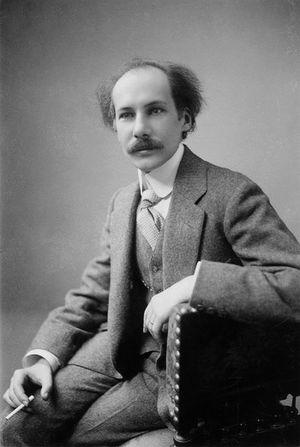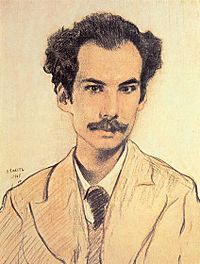Andrei Bely facts for kids
Quick facts for kids
Andrei Bely
|
|
|---|---|

Bely in 1912
|
|
| Born | Boris Nikolaevich Bugaev October 26, 1880 Moscow, Russian Empire |
| Died | January 8, 1934 (aged 53) Moscow, Russian SFSR, USSR |
| Occupation | Prose writer, poet, essayist, literary critic, dramatist |
| Alma mater | Imperial Moscow University (1903) |
| Period | 1900—1934 |
| Literary movement | Russian symbolism, modernism |
| Notable works | The Silver Dove (1910) Petersburg (1913/1922) |
| Signature | |
Boris Nikolaevich Bugaev (Russian: Бори́с Никола́евич Буга́ев, IPA: [bɐˈrʲis nʲɪkɐˈlajɪvʲɪtɕ bʊˈɡajɪf]), better known by the pen name Andrei Bely or Biely (Russian: Андре́й Бе́лый, IPA: [ɐnˈdrʲej ˈbʲelɨj]; 26 October [O.S. 14 October] 1880 – 8 January 1934), was a Russian novelist, Symbolist poet, theorist and literary critic. He was a committed anthroposophist and follower of Rudolf Steiner. His novel Petersburg (1913/1922) was regarded by Vladimir Nabokov as the third-greatest masterpiece of modernist literature. The Andrei Bely Prize (Russian: Премия Андрея Белого), one of the most important prizes in Russian literature, was named after him. His poems were set to music and performed by Russian singer-songwriters.
Life
Boris Bugaev was born in Moscow, into a prominent intellectual family. His father, Nikolai Bugaev, was a noted mathematician who is regarded as a founder of the Moscow school of mathematics. His mother, Aleksandra Dmitrievna (née Egorova), was not only highly intelligent but a famous society beauty, and the focus of considerable gossip. She was also a pianist, providing Bugaev his musical education at a young age.
Young Boris grew up at the Arbat, a historical area in Moscow. He was a polymath whose interests included mathematics, biology, chemistry, music, philosophy, and literature. Bugaev attended university at the University of Moscow. He would go on to take part in both the Symbolist movement and the Russian school of neo-Kantianism. Bugaev became friendly with Alexander Blok and his wife; he fell in love with her, which caused tensions between the two poets. Buagev was invited but was unable to attend their wedding due to his father's death.
Nikolai Bugaev was well known for his influential philosophical essays, in which he decried geometry and probability and trumpeted the virtues of hard analysis. Despite—or because of—his father's mathematical tastes, Boris Bugaev was fascinated by probability and particularly by entropy, a notion to which he frequently refers in works such as Kotik Letaev.
As a young man, Bely was strongly influenced by his acquaintance with the family of philosopher Vladimir Solovyov, especially Vladimir's younger brother Mikhail, described in his long autobiographical poem The First Encounter (1921); the title is a reflection of Vladimir Solovyov's Three Encounters. It was Mikhail Solovyov who gave Bugaev his pseudonym Andrei Bely.

In his later years Bely was influenced by Rudolf Steiner’s anthroposophy and became a personal friend of Steiner's. His ideas covering this philosophy included his attempts to connect Vladimir Solovyov's philosophical ideas with Steiner's Spiritual Science. One of his notions was the Eternal Feminine, which he equated it with the "world soul" and the "supra-individual ego", the ego shared by all individuals. He spent time between Switzerland, Germany, and Russia, during its revolution. He supported the Bolshevik rise to power and later dedicated his efforts to Soviet culture, serving on the Organizational Committee of the Union of Soviet Writers. He died, aged 53, in Moscow. Several of the numerous poems written in Moscow in January 1934 were inspired by Bely's death.
Legacy and literary career
Bely started his literary career as the author of The Symphonies, a cycle experimental prose works, written from 1900 to 1908. In 1909 he published his first novel The Silver Dove. As critics note, it is notable for its skaz techniques and its unique ornamental prose, for its "ability to capture haunting, mesmerizing sense of apocalyptic doom". The novel is the first part of Bely's unfinished trilogy East or West.
Bely's novel Petersburg (1913/1922), the second part of the unfinished trilogy, is generally considered to be his masterpiece. The book employs a striking prose method in which sounds often evoke colors. The novel is set in the somewhat hysterical atmosphere of turn-of-the-century Petersburg and the Russian Revolution of 1905. To the extent that the book can be said to possess a plot, this can be summarized as the story of the hapless Nikolai Apollonovich, a ne'er-do-well who is caught up in revolutionary politics and assigned the task of assassinating a certain government official — his own father. At one point, Nikolai is pursued through the Petersburg mists by the ringing hooves of the horse in the famous bronze statue of Peter the Great. There are scholars who have suggested that Petersburg included ideas from Sigmund Freud's therapeutic method. An example is the way in which psychoanalysis was used as Bely's interpretive tool for literary criticism, and as a source of creativity.
After the Revolution, Bely wrote two psychological autobiographical novels, highly influenced by Rudolf Steiner's anthroposophy, Kotik Letaev (1918) and The Christened Chinaman (1921). D. S. Mirsky called Kotik Letaev "Bely's most unique and original work", while The Christened Chinaman was called by Mirsky "the most realistic and the most amusing of Bely's works". He also wrote poems Christ is Risen (1918), in which he glorifies the Revolution, Glossolalia (1917), and The First Encounter (1921).
Bely's last novel is Moscow (1926—1932), an attempt to give an image of Russian intelligentsia during World War I and the Russian Revolution. It differs from The Silver Dove and Petersburg with complex, multi-faceted characters who experience a transformation of personality. It also continues Bely's linguistic experiments. The first part of Moscow, The Moscow Eccentric, was published in English in 2016, the other two are not translated yet.
Bely's essay Rhythm as Dialectic in The Bronze Horseman is cited in Nabokov's novel The Gift, where it is mentioned as "monumental research on rhythm". Fyodor, poet and main character, praises the system Bely created for graphically marking off and calculating the 'half-stresses' in the iambs. Bely found that the diagrams plotted over the compositions of the great poets frequently had the shapes of rectangles and trapeziums. Fyodor, after discovering Bely's work, re-read all his old iambic tetrameters from the new point of view, and was terribly pained to find out that the diagrams for his poems were instead plain and gappy. Nabokov's essay "Notes on Prosody" follows for the large part Bely's essay "Description of the Russian Iambic Tetrameter" (published in the collection of essays Symbolism).
See also
 In Spanish: Andréi Bely para niños
In Spanish: Andréi Bely para niños
- Alexander Blok
- Aleksey Remizov
- Fyodor Sologub
- Russian Symbolism
- Russian literature

